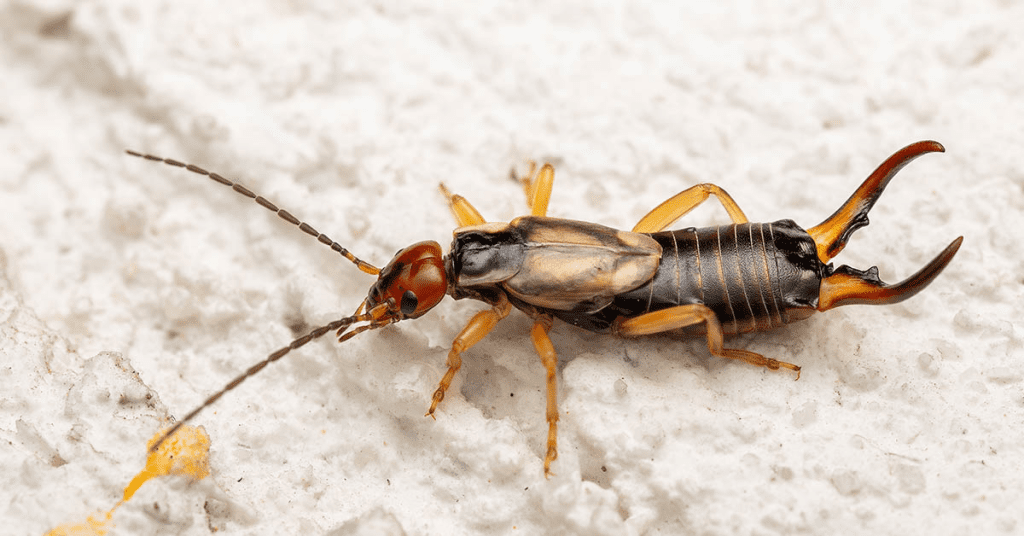Earwigs put the “creepy” in creepy crawlies with their scuttling legs and long pincers on their tails. Many old myths claim these insects crawl into people’s ears and burrow into their heads. Fortunately, that’s just folklore! While earwigs look scary, they are generally harmless to humans. However, their sudden appearance in your home or garden might indicate a growing infestation.
Do Earwigs Bite?

Technically, earwigs don’t bite. Their pincers (or cerci) might look intimidating, but they primarily use them for defense and capturing prey. If an earwig feels threatened, it may pinch—but it’s not venomous or dangerous. The pinch might cause slight irritation or redness, but it won’t break the skin. If your son was “bitten,” it’s worth considering other bug possibilities, like spiders or certain beetles.
What Attracts Earwigs to Homes?
Earwigs thrive in damp, dark environments. If you’re noticing them indoors, they may be seeking shelter from extreme temperatures or a source of moisture. Some common attractants include:
- Damp Areas: Leaky pipes, basements, and bathrooms are prime spots for earwigs.
- Decaying Matter: These bugs feast on rotting wood, leaves, and organic debris.
- Other Insects: Earwigs are opportunistic feeders, preying on smaller insects.
- Mulch & Leaf Piles: Gardeners often find earwigs hiding in moist mulch beds and plant debris.
Signs of an Earwig Infestation
Earwigs are nocturnal, making them tricky to spot during the day. However, if you notice any of the following signs, you may have an infestation:
- A Foul, Musky Smell: Earwigs release an odor when threatened.
- Tiny, Black Excrement Pellets: You might find their droppings in kitchen areas or basements.
- Damaged Plants: Small holes or ragged edges on leaves indicate earwig feeding.
- Sightings in Dark, Damp Areas: They often hide under furniture, in bathrooms, or near drains.
How to Get Rid of Earwigs in Your Home
If you’ve spotted earwigs indoors, it’s time to take action. Here’s how you can eliminate them:
1. Remove Moisture Sources
Since earwigs love damp environments, reducing humidity is crucial. Fix leaky pipes, improve ventilation, and use a dehumidifier in problem areas.
2. Seal Entry Points
Prevent earwigs from coming inside by sealing cracks and gaps around windows, doors, and foundation walls. Use weather stripping and caulk to block their entry.
3. Clean Up Indoors
- Regularly sweep and vacuum floors to remove food crumbs.
- Empty trash bins frequently.
- Store food in sealed containers.
4. Use Traps
Try DIY traps to capture earwigs hiding in your home:
- Rolled-up Damp Newspaper: Earwigs crawl inside overnight. Dispose of it in the morning.
- Vegetable Oil & Soy Sauce Trap: Fill a shallow dish with equal parts of soy sauce and oil. The scent lures them in, and the oil drowns them.
- Sticky Tape or Traps: Place near baseboards, doorways, and other entry points.
How to Get Rid of Earwigs in Your Garden

Earwigs play a role in nature by eating decomposing matter and smaller pests, but too many can wreak havoc on your plants. Here’s how to keep them under control:
1. Remove Hiding Spots
- Clear away leaf piles, woodpiles, and old plant debris.
- Avoid using excessive mulch near your home’s foundation.
- Turn over rocks and logs during the day to expose and eliminate earwigs.
2. Introduce Natural Predators
Birds, frogs, and toads help keep earwig populations in check. Encourage these natural predators by adding a bird feeder or a small water source in your yard.
3. Use Diatomaceous Earth
Sprinkle food-grade diatomaceous earth around plants and soil. This natural powder dehydrates and kills earwigs without harming pets or beneficial insects.
4. Apply Neem Oil or Essential Oils
Neem oil disrupts insect growth cycles, making it harder for earwigs to thrive. Essential oils like peppermint, cinnamon, and eucalyptus also repel these pests.
How to Prevent Future Infestations
The best way to avoid another earwig invasion is to create an environment they don’t like. Here are some preventive measures:

- Keep Indoor Spaces Dry: Repair leaks, wipe down damp areas, and use a dehumidifier.
- Store Firewood & Mulch Away from the House: Keep them at least 5-10 feet from your home’s foundation.
- Install Proper Drainage: Ensure gutters and downspouts direct water away from your house.
- Use Outdoor Lights Sparingly: Earwigs are attracted to light. Turn off unnecessary outdoor lights at night.
When to Call a Pest Control Expert
If earwigs continue appearing in large numbers despite your efforts, it might be time to call a professional pest control service. An exterminator can assess the situation and use targeted treatments to eliminate the infestation safely.
Conclusion
While earwigs look terrifying, they are mostly harmless to humans. Their pincers may pinch, but they don’t bite, sting, or carry diseases. However, a sudden increase in earwigs indoors may indicate excess moisture or a food source that’s attracting them. By addressing these issues and using effective pest control methods, you can keep your home and garden free from these creepy crawlers. If the problem persists, professional pest control can provide a long-term solution.


